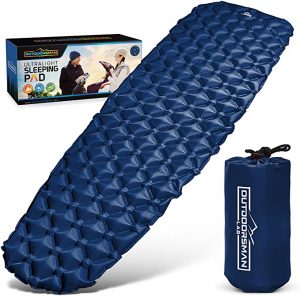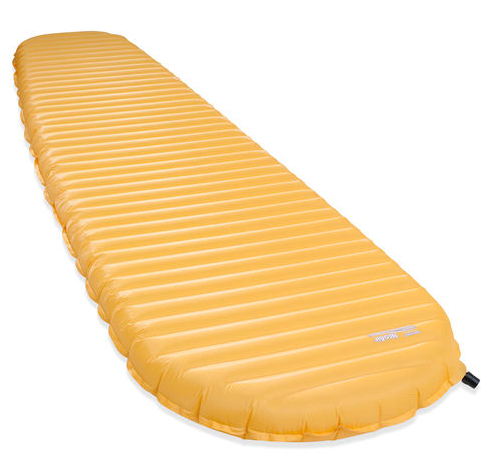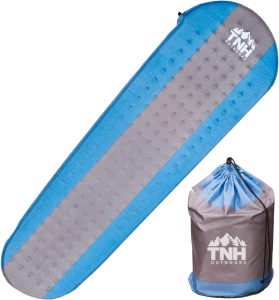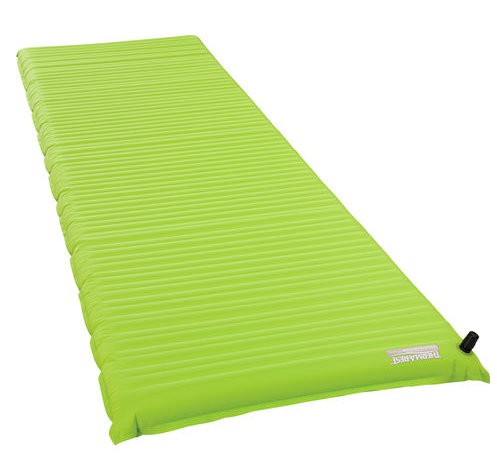We all know sleep is pretty important. It is especially important when you are out in the wilderness on a multi day backpacking trip. Even if you aren’t busting through a workout all day, its nice to be able to camp comfortable wherever you end up. This post aims to help you decide what’s best for your needs, and also provide links to some of the best sleeping pads for camping, hiking, car trips, or whatever you need them for.
Types of Sleeping Pads
Self Inflating Pads
Self-inflating sleeping pads have an open-cell foam layer that allows the mattress to inflate automatically and quickly. The auto inflation allows for a quick and easy setup of a relatively comfy sleeping pad. Many of these pads can be inflated more via manual inflation to get the proper firmness. Self inflating pads run the risk of popping, or getting leaks. For this reason, it is a good idea to cary repair kits which can often be included with the purchase or purchased separately. Self inflated pads usually pack up nice and small, but are heavier than foam pads. They make self inflating pads warm enough for winter.
Best Used For: Backpacking, overnight hiking, car camping
Closed Cell Foam Pads
The foam sleeping pad is the most basic sleeping pad style. Foam pads are lightweight, durable, and often the most affordable sleeping pad option. Because they don’t pack up very small, you pretty much have to pack them by strapping them to the outside of your pack. They make pads warm enough for winter. Foam pads are usually the least comfortable sleeping pad option.
Best Used For: Mountaineering, ice climbing, bike touring, thru-hiking, ultralight adventures, basically anything where weight is a concern.
Manual Inflating Pads
Manual inflation pads are often lighter weight than self inflating pads and less expensive. Of course, they require manually blowing into a valve on the end of the pad or using a manual pump. They also make these pads warm enough for winter camping.
Best Used For: Backpacking, lightweight camping, car camping, if you need a comfortable mattress
What to Look For In a Sleeping Pad
Durability
If you aren’t going to be able to be careful with your pad, and it is going to take a beating, you may be better off getting a foam pad that can’t pop or really break in any way. Not only are the less expensive, but they can take a serious beating. You also will be able to put it down on dirt, or rocks wherever if you are just looking for a place to sit. Blow up pads can be pretty durable, but they can’t take a beating like foam pads.
Packability (Weight and Size)
If you are backpacking, it is really nice to save weight and pack size. Nothing is quite as light as foam pads, but they don’t pack up so nicely. Most foam pads you will have to strap onto the outside of your bag, while blow ups can weigh slightly more, they can pack very nicely into your bag.
Price
This one is pretty straightforward. If you are on a budget, foam is probably the way to go. If you are willing to dish out some extra cash for comfort, warmth, and packability, blow up pads are amazing.
Insulation
A sleeping pad’s ability to insulate is measured using an R-value, a measurement of a materials thermal resistance. The higher the R-value, the warmer it will be. This is especially important if you are camping in winter, where having an R value above 5 will keep you warm in almost any conditions.
Size
Bigger people need bigger pads, and they do come in different sizes.
The Best Sleeping Pads for Camping
The Best Manual Inflation Pads
Klymit Insulated Static V Lite
 We placed this at the top of our list because of the overall value of it. It is similar quality to the highest end pads, while being substantially less expensive. Klymit has done an incredible job of producing high quality gear at more affordable prices. This sleeping pad has a great R rating, is comfortable enough even for side sleepers like us, and packs nice and small.
We placed this at the top of our list because of the overall value of it. It is similar quality to the highest end pads, while being substantially less expensive. Klymit has done an incredible job of producing high quality gear at more affordable prices. This sleeping pad has a great R rating, is comfortable enough even for side sleepers like us, and packs nice and small.
This is a great value pad that will work in cold weather, yet not weigh you down.
| Compacted Size | 8 x 3 in / 20 x 8 cm |
|---|---|
| Inflated Size | 72 x 23 x 2.5 in / 183 x 58 x 6 cm |
| Inflation | Quick inflation with 10-15 breaths and deflates well with rolling |
| Thickness (Inflated) | Thickness: 2.5″ |
| Material | 30D polyester |
| Warranty | Lifetime |
| Colors | Orange |
| R-Value | 4.4 (4 season level warmth) – See our article on R-Values |
| Weight | 20 oz / 567 g |
View On Amazon | View On Klymit | View On REI
OutdoorsmanLab Camping Sleeping Pad

This is probably the best value sleeping pad out there. With an incredibly small and light pack size, this durable pad comes highly recommended. You can view a full review of this product here.
| Compacted Size | Compact Size: 8″ x 3″ x 3″ for carrying and storage |
|---|---|
| Inflated Size | Inflated Size: 73″ x 21.6″ x 2.2″ fits all types of single sleeping bags |
| Inflation | Easy-to-Use Air Valve: Quick inflation with 10-15 breaths and deflates in seconds |
| Thickness (Inflated) | Thickness: 2.2″ for optimal comfort, support, and warmth |
| Weight | 14.5 0unces (just under 1 pound) |
| Material | durable 200 ripstop woven Nylon with a laminated TPU coating |
| Colors | Available in Blue, Green, and Orange |
| R-Value | 2.2 (3 season level warmth) – See our article on R-Values |
THERM-A-REST NeoAir Xlite Sleeping Pad, Regular

If you need light, super comfortable option, this is one of the best out there.
Weight: 12 oz / .35 kg
Size: 72 inches by 20 inches wide. 2.5 inches thick.
R Value: 3.2 (good for almost any situation)
Pack Size: 9″ x 4″
THERM-A-REST NeoAir® Venture™ Sleeping Pad, Regular
Durable, comfortable, and from one of the best pad making companies. Great comfort reviews across the board and no reports of leaking. Lightweight, and easy to blow up.
Weight: 1 lb, 4 oz
Size: 72 inches by 20 inches wide. 2 inches thick.
R Value: 1.8 (in winter, use a foam pad underneath)
Pack Size: 23 x 11.5 inches (diameter) rolled.
View On Amazon | View On EMS | View On Backcountry
The Best Self Inflating Pads
TNH Outdoors Premium Self Inflating Sleeping Pad

This is one of the best pads for the money. Warm, comfortable, fantastic company and warranty, and great reviews by many. The pack size is a on the larger size.
Weight: 2.09 Pounds (950 grams)
Size: 72 inches by 22 inches wide. 1.5 inches thick.
R Value: 3-4 (good for almost any situation)
Pack Size: 15.9 x 9.8 x 6.5 inches (diameter) rolled.
The Best Foam Pads
Therm-A-Rest Z Lite Sol Ultralight Foam Backpacking Sleeping Pad

This is probably the best and most comfortable foam pad out there. In addition to being extremely lightweight, the foldable design makes it easy to strap onto the outside of any bag.
Weight: 10 Ounces
Sizes: Comes in a short and long sizes
R Value: 2.6 (Not ideal for cold winters, but it is doable)
Pack Size: 20 x 5 x 5.5 inches
Therm-A-Rest RidgeRest Classic Foam Camping Sleeping Pad
This is Therm-A-Rest’s most basic and inexpensive option. It’s lightweight and works even in winter, and won’t hurt your wallet. This option isn’t nearly as comfortable as the z lite option, but you can’t go wrong with the price.
Weight: 14 Ounces
Sizes: Comes in multiple lengths for different sized people
R Value: 2.6 (Not ideal for cold winters, but it is doable)
Pack Size: 20 x 8 inches (diameter) rolled.
View On Amazon | View On Therm-a-Rest | View On REI
Max DesMarais is the founder of hikingandfishing.com. He has a passion for the outdoors and making outdoor education and adventure more accessible. Max is a published author for various outdoor adventure, travel, and marketing websites. He is an experienced hiker, backpacker, fly fisherman, backcountry skier, trail runner, and spends his free time in the outdoors. These adventures allow him to test gear, learn new skills, and experience new places so that he can educate others. Max grew up hiking all around New Hampshire and New England. He became obsessed with the New Hampshire mountains, and the NH 48, where he guided hikes and trail runs in the White Mountains. Since moving out west, Max has continued climbed all of the Colorado 14ers, is always testing gear, learning skills, gaining experience, and building his endurance for outdoor sports. You can read more about his experience here: hikingandfishing/about

